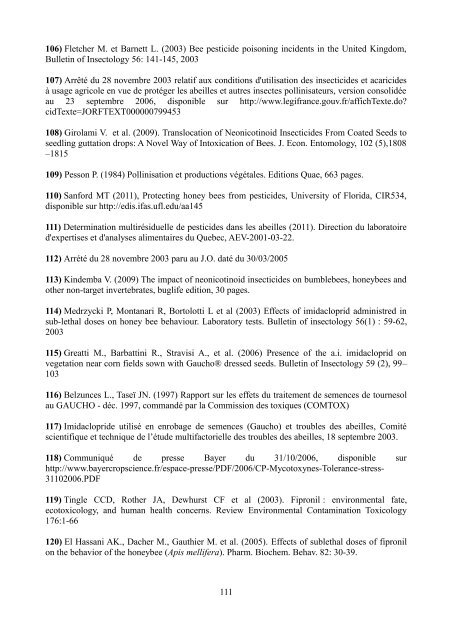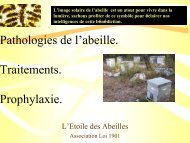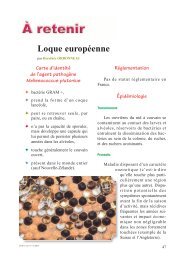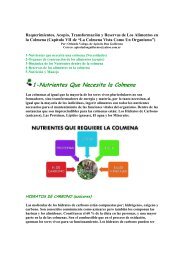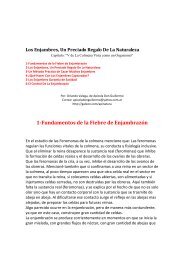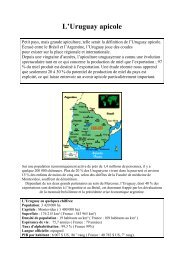La disparition des abeilles (Colony Collapsus Disorder)
La disparition des abeilles (Colony Collapsus Disorder)
La disparition des abeilles (Colony Collapsus Disorder)
You also want an ePaper? Increase the reach of your titles
YUMPU automatically turns print PDFs into web optimized ePapers that Google loves.
106) Fletcher M. et Barnett L. (2003) Bee pesticide poisoning incidents in the United Kingdom,<br />
Bulletin of Insectology 56: 141-145, 2003<br />
107) Arrêté du 28 novembre 2003 relatif aux conditions d'utilisation <strong>des</strong> insectici<strong>des</strong> et acarici<strong>des</strong><br />
à usage agricole en vue de protéger les <strong>abeilles</strong> et autres insectes pollinisateurs, version consolidée<br />
au 23 septembre 2006, disponible sur http://www.legifrance.gouv.fr/affichTexte.do?<br />
cidTexte=JORFTEXT000000799453<br />
108) Girolami V. et al. (2009). Translocation of Neonicotinoid Insectici<strong>des</strong> From Coated Seeds to<br />
seedling guttation drops: A Novel Way of Intoxication of Bees. J. Econ. Entomology, 102 (5),1808<br />
–1815<br />
109) Pesson P. (1984) Pollinisation et productions végétales. Editions Quae, 663 pages.<br />
110) Sanford MT (2011), Protecting honey bees from pestici<strong>des</strong>, University of Florida, CIR534,<br />
disponible sur http://edis.ifas.ufl.edu/aa145<br />
111) Determination multirésiduelle de pestici<strong>des</strong> dans les <strong>abeilles</strong> (2011). Direction du laboratoire<br />
d'expertises et d'analyses alimentaires du Quebec, AEV-2001-03-22.<br />
112) Arrété du 28 novembre 2003 paru au J.O. daté du 30/03/2005<br />
113) Kindemba V. (2009) The impact of neonicotinoid insectici<strong>des</strong> on bumblebees, honeybees and<br />
other non-target invertebrates, buglife edition, 30 pages.<br />
114) Medrzycki P, Montanari R, Bortolotti L et al (2003) Effects of imidacloprid administred in<br />
sub-lethal doses on honey bee behaviour. <strong>La</strong>boratory tests. Bulletin of insectology 56(1) : 59-62,<br />
2003<br />
115) Greatti M., Barbattini R., Stravisi A., et al. (2006) Presence of the a.i. imidacloprid on<br />
vegetation near corn fields sown with Gaucho® dressed seeds. Bulletin of Insectology 59 (2), 99–<br />
103<br />
116) Belzunces L., Taseï JN. (1997) Rapport sur les effets du traitement de semences de tournesol<br />
au GAUCHO - déc. 1997, commandé par la Commission <strong>des</strong> toxiques (COMTOX)<br />
117) Imidaclopride utilisé en enrobage de semences (Gaucho) et troubles <strong>des</strong> <strong>abeilles</strong>, Comité<br />
scientifique et technique de l’étude multifactorielle <strong>des</strong> troubles <strong>des</strong> <strong>abeilles</strong>, 18 septembre 2003.<br />
118) Communiqué de presse Bayer du 31/10/2006, disponible sur<br />
http://www.bayercropscience.fr/espace-presse/PDF/2006/CP-Mycotoxynes-Tolerance-stress-<br />
31102006.PDF<br />
119) Tingle CCD, Rother JA, Dewhurst CF et al (2003). Fipronil : environmental fate,<br />
ecotoxicology, and human health concerns. Review Environmental Contamination Toxicology<br />
176:1-66<br />
120) El Hassani AK., Dacher M., Gauthier M. et al. (2005). Effects of sublethal doses of fipronil<br />
on the behavior of the honeybee (Apis mellifera). Pharm. Biochem. Behav. 82: 30-39.<br />
111


